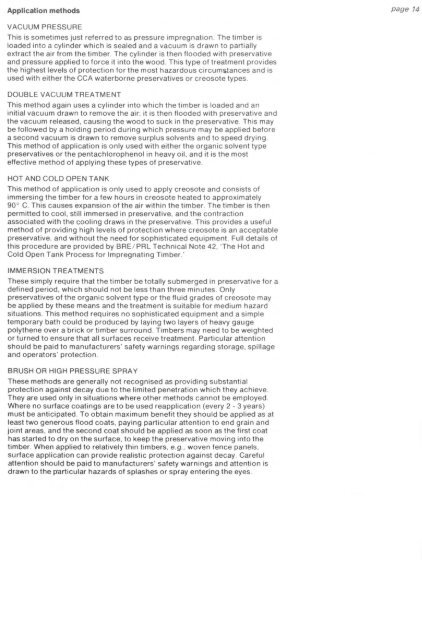information - Scottish Natural Heritage
information - Scottish Natural Heritage
information - Scottish Natural Heritage
Create successful ePaper yourself
Turn your PDF publications into a flip-book with our unique Google optimized e-Paper software.
Application methods<br />
VACUUM PRESSURE<br />
This is sometimes just referred to as pressure impregnation. The timber is<br />
loaded into a cylinder which is sealed and a vacuum is drawn to partially<br />
extract the air from the timber. The cylinder is then flooded with preservative<br />
and pressure applied to force it into the wood. This type of treatment provides<br />
the highest levels of protection for the most hazardous circumstances and is<br />
used with either the CCA waterborne preservatives or creosote types.<br />
DOUBLE VACUUM TREATMENT<br />
This method again uses a cylinder into which the timber is loaded and an<br />
initial vacuum drawn to remove the air; it is then flooded with preservative and<br />
the vacuum released, causing the wood to suck in the preservative. This may<br />
be followed by a holding period during which pressure may be applied before<br />
a second vacuum is drawn to remove surplus solvents and to speed drying.<br />
This method of application is only used with either the organic solvent type<br />
preservatives or the pentachlorophenol in heavy oil, and it is the most<br />
effective method of applying these types of preservative.<br />
HOT AND COLD OPEN TANK<br />
This method of application is only used to apply creosote and consists of<br />
immersing the timber for a few hours in creosote heated to approximately<br />
90° C. This causes expansion of the air within the timber. The timber is then<br />
permitted to cool, still immersed in preservative, and the contraction<br />
associated with the cooling draws in the preservative. This provides a useful<br />
method of providing high levels of protection where creosote is an acceptable<br />
preservative, and without the need for sophisticated equipment. Full details of<br />
this procedure are provided by BRE/ PRL Technical Note 42, 'The Hot and<br />
Cold Open Tank Process for Impregnating Timber.'<br />
IMMERSION TREATMENTS<br />
These simply require that the timber be totally submerged in preservative for a<br />
defined period, which should not be less than three minutes. Only<br />
preservatives of the organic solvent type or the fluid grades of creosote may<br />
be applied by these means and the treatment is suitable for medium hazard<br />
situations. This method requires no sophisticated equipment and a simple<br />
temporary bath could be produced by laying two layers of heavy gauge<br />
polythene over a brick or timber surround. Timbers may need to be weighted<br />
or turned to ensure that all surfaces receive treatment. Particular attention<br />
should be paid to manufacturers' safety warnings regarding storage, spillage<br />
and operators' protection.<br />
BRUSH OR HIGH PRESSURE SPRAY<br />
These methods are generally not recognised as providing substantial<br />
protection against decay due to the limited penetration which they achieve.<br />
They are used only in situations where other methods cannot be employed.<br />
Where no surface coatings are to be used reapplication (every 2 - 3 years)<br />
must be anticipated. To obtain maximum benefit they should be applied as at<br />
least two generous flood coats, paying particular attention to end grain and<br />
joint areas, and the second coat should be applied as soon as the first coat<br />
has started to dry on the surface, to keep the preservative moving into the<br />
timber. When applied to relatively thin timbers, e.g., woven fence panels,<br />
surface application can provide realistic protection against decay. Careful<br />
attention should be paid to manufacturers' safety warnings and attention is<br />
drawn to the particular hazards of splashes or spray entering the eyes.<br />
page 14

















